After getting noticed for her film Devi, filmmaker Priyanka Banerjee is starting a new chapter in her career by venturing into international space with her next. And she admits it is a challenging yet exciting step.
Banerjee has directed a segment for an international anthology project. Her segment puts a spotlight on a teenager who refuses to come out of the bathroom, and the reason behind it.
“I started out acting and directing plays when I was 17 years old, so there was always a very natural draw towards bringing texts alive and creating 3-dimensional worlds out of stories. Somewhere along the way in college, I started experimenting with film and making my own short films. While the first few travelled to film festivals and I had that experience, it was when I made Devi in 2020 that it really felt like I got an official start in the industry. Since then, I’ve directed and produced multiple commercials, while writing what my next few fiction releases will be. Currently, to have just done this project with institutions of cinema like Paramount, really feels like breaking new ground. I am very excited to now explore telling even more stories at an international scale,” she says.
The Devi maker adds, “I’ve also taken the risk to do the film in Bengali- while that does limit the audience to those willing to read subtitles, I am confident that it adds to the truth of my story”.
For her, it is an interesting challenge. She shares, “The interesting thing about this anthology of films is that it is by 5 handpicked directors from across the world- we belong to India, Kenya, Nigeria, Brazil and USA. So the first challenge was to establish a virtual writers’ room in 2023 where we had to coordinate across time zones and cultures, and figure out how to work together to have our scripts in place and more importantly, that they all still feel connected to one another. Another unique thing in our process was that we had to shoot all 5 films in Johannesburg, South Africa. Considering each of our films are steeped in our respective cultures, we had to work with our production designer and director of photography to find a look for each of our films that felt true to where we came from. As challenging as these things were, they were also the most rewarding. I’m sure no one who watches these films will be able to tell that we didn’t shoot them in their home countries. And these 4 filmmakers have become some of my closest friends over the course of this process!”
When it comes to the issue of lack of diversity and inclusion in the industry, she is pitching in to change it. “Nearly all film industries around the world are criticised for their under-representation of women, especially in technical roles. While our stories range from talking about gender-based violence to HIV to the unpaid labour work of women and child marriage, our process behind the scenes also saw a great representation of women. 60% of our crew was female, which felt apt for a project like this. Personally, even on my projects in India, I do my best to maintain the gender ratio in my crews and work with people who understand the sensitivity required to shoot stories like these. That’s how I think we can all do our bit to make the industry more diverse and inclusive,” she ends.











